Final report for OS16-093
Project Information
One major advantage the Southern U.S. has over other crop production areas is a long growing season, making it possible to double-crop winter and summer crops. The most popular double-cropping system is winter wheat followed by soybean. Some growers are currently double-cropping cotton and peanut after wheat; however, the longer growing season requirements for cotton and peanut limit the yield potential for these cropping systems.
Recently, growers in the Southern U.S. are facing new production problems that are either reducing farm profits and sustainability or threatening soil conservation practices:
- With herbicide-resistant weeds spreading throughout the Southeast, soil-applied residual herbicides have become the most adopted method to manage herbicide-resistant weeds (such as Palmer amaranth). An aggressive soil and foliar herbicide program can cost up to $40/acre; however, hand-weeding, cultivation, and crop abandonment will cost growers over $900/acre in lost revenue and increased production costs. Cover crops can be used effectively to suppress herbicide-resistant weeds; however, growers often express frustration with the poor performance of no-till coulters on their planting equipment in dealing with the crop residue.
- Control costs for and damage caused by insects also pose production problems perennially. According to loss estimates provided in the Proceedings of the Beltwide Cotton Production Conferences, cotton producers across the USA lost about $100 million to thrips during 2008-2010. With at-plant preventative treatments and foliar applications combined, control costs during the same period are in the tens of millions as well. Thrips were ranked as the second most important group of cotton insect pests in 2011 across the USA, but represented the most important group in the Southeast last season.
- Additionally, nematodes cause hundreds of millions of dollars in yield losses annually to USA cotton, soybean, and peanut. Nematode management relies heavily on the use of nematicides such as Temik 15G ($15-18/acre) or Telone II ($42/acre); However, the most effective tool for managing nematodes (aldicarb -- AgLogic 15G) currently is only available in the Southeastern USA in limited amounts. In addition, currently there is a shortage of Telone II nematicide in the USA.
- Finally, the cost of fuel represents over 30% of the total costs of owning and operating farm tractors. It is important that every effort be made to reduce energy use in agricultural production from both standpoints of economics and availability.
A double-cropping system developed at Clemson University allows interseeding or planting of one crop such as soybean, cotton, or peanut into a second crop, such as winter wheat, 2-3 weeks before harvest of the second crop. This system has the potential to overcome all of the production problems cited above.
The overarching goal of this demonstration project was to assist producers of cotton, soybean, peanut, and wheat with adoption of innovative conservation technologies and approaches for crop production to enhance soil properties, environmental quality, and farm profits, while reducing energy consumption and pest occurrence. Our supporting Objectives included:
- Establish two on-farm research sites “Prototype Fields” to directly train growers in the use, benefits, and effectiveness of interseeding technology;
- Modify farmers’ equipment (or utilize our own equipment) to allow for interseeding, and provide training and support to ensure proper use; and
- Implement an aggressive training program for crop consultants and county Extension agents to become the primary providers of interseeding technology for growers beyond the geographic and time limitations of this project.
Cooperators
Research
We have made significant progress toward achieving project goals and objectives:
Equipment Modifications: We modified existing grower equipment. For planting small grain, we modified growers' conventional grain drills by blocking some of the seed tubes for planting wheat. For soybean farmers, every other tube was blocked on the grain drill. This provided skip rows (blank) in wheat for interseeding narrow-row soybean (15 inches) the following May. We also used the Clemson interseeder/planter (Figure 1-A) to plant wheat and interseed narrow row soybeans. For row crop farmers (38-in rows), one out of every five seed tubes of the grain drill were blocked to provided skip rows for interseeding cotton and peanut. In addition, to make this technology more adoptable by growers, a 4-row John Deere 1700 vacuum planter (configuration used by most row crop farmers) was modified for interseeding cotton, peanut, and wide-row soybean into standing wheat. The wide planting units on this planter were replaced with four units of JD narrow row planters. This system is designed to fit in narrow skips between wheat rows (Figure 1-B). Small beds generated during wheat planting provided an excellent non-compacted zone for the subsequent interseeding operation.
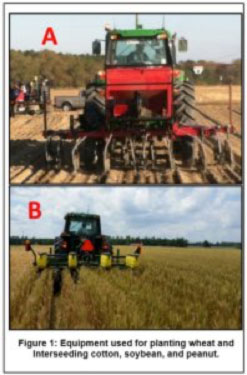
Demonstration Sites: We established 4 on-farm sites to demonstrate the advantages of the interseeding technology in cotton, peanut, and soybean productions. In anticipation of this project’s start date, skip-row wheat was planted (around mid-November in 2015 and 2016) in these sites using either modified grain drills or the Clemson interseeding drill/planter (Figure 2-A). The distance between skip rows were 15 inches for interseeding narrow-row soybean, 30 inches for interseeding 30-inch soybean (in one farm), and 38-inches for interseeded cotton and peanut. The drill was adjusted to maintain the same seeding rate (lbs./acre) as in conventional solid wheat.
Soybean, cotton, or peanut were interseeded into standing wheat (based on grower’s preference or rotation) around Mid-May in 2016 and 201 at all on-farm demonstration sites. Figure 2-B shows an interseeded soybean field before wheat harvest. The interseeded soybean’s plant height in demonstration sites, ranged from 6 to 12 inches at the time of wheat harvest. Also, interseeded cotton had between 2 to 4 true leaves at wheat harvest (Figure 2-C). In addition to interseeded crops, conventional seeded plots using standard practices for cotton, peanut (Figure 2-D), and soybean production were established for side-by-side comparison. The participating farmers were trained to use this technology.
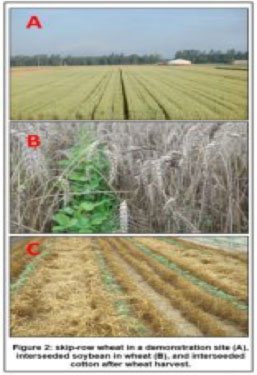
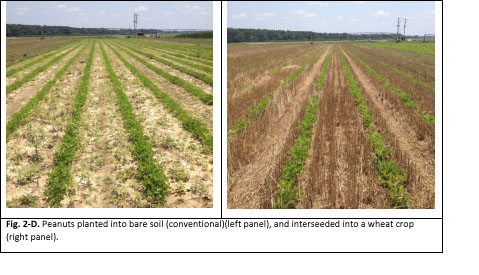
At the Edisto Research and Education Center (REC) demonstration site, we established insect, nematode, and weed treatments (with and without herbicide programs) in each crop to compare the effect of interseeding on pest incidence. Also, soil properties including chemical, physical, and biological were determined for different production systems.
Wheat was harvested around first week in June 2016 and 2017 using a grain combine equipped with a yield monitor. Row crops (soybean, cotton, and peanut) were harvested around mid-October in 2016 and 2017 from demonstration sites. We utilized a spindle picker, grain combine, and peanut harvester equipped with AgLeader yield monitors, which allowed us to map variations in crop yields across the production fields to document economic benefits of this technology.
Soil cores were collected from demonstration sites and were analyzed for soil chemicals and nematode population densities. Weed biomass was collected using a 0.45 m2 quadrat during and at the end of the season in both untreated and treated plots to quantify effect of residue on weed populations.
The results from the demonstration sites indicated that:
Wheat yields were not affected by row spacing or interseeding in all demonstration sites in both years. Although in 2016 wheat yields in interseeded plots were numerically higher than conventional plots (67 vs. 64, respectively), the differences were not statistically significant.
Soybeans:
Interseeded soybeans yielded significantly more than conventional double-cropped soybeans in demonstration sites. The yield increases were 27% and 43% at two demonstration sites in 2016 and 2017. Figure 3 shows an example of yield differences between interseeded and conventional double-cropped soybeans from one of the demonstration sites. There were no differences in yield between mono-cropped and interseeded soybeans. Although not statistically significant, on average narrow-row interseeded soybean yielded 10% higher than mono-crop, full season soybeans.
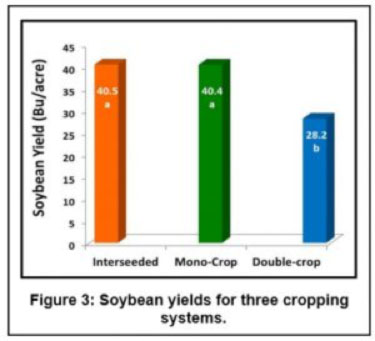
Crop residue associated with the wheat in the interseeding production systems significantly reduced weed infestation (including herbicide resistant weeds, such as Palmer Amaranth in both cotton, peanut, and soybean. Figure 4-A shows an example of reduction in weed densities due to cropping systems in 2016 and 2017 (combined across years and cropping systems). Weed infestation reduced crop yields. Reductions in soybean yield due to weed infestations, where herbicides were not applied, were significantly less at 26% in interseeded plots compared to 76% for conventional double-cropped soybean. Narrow row interseeded soybeans also suppressed other weeds such as grass and nutsedge. No herbicides were applied in demonstration sites to the narrow-row interseeded soybeans, while the conventional double cropped soybeans received at least two applications of herbicides. This was a savings of about $36 savings per acre.
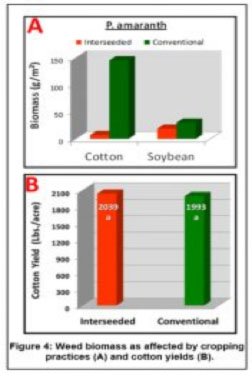
Since narrow-row interseeded-soybean increased yields numerically (10%) compared to 38-inch mono-crop, full season soybeans, and since it significantly suppressed the weed infestation; therefore, we are recommending only narrow-row interseeding scheme for farm production.
Cotton:
There were no differences in yield between mono-cropped and interseeded cotton. However, revenues from the interseeded cotton were higher due to harvest of the wheat crop (about 60 to 80 Bu per acre). Figure 4-B shows seed cotton yields for conventional and interseeded system at Barnwell County demonstration site in 2016 and 2017.
Peanuts:
The peanuts field irrigation experiment was conducted in 2016 and 2017 at the Edisto Research and Education Center under a lateral move irrigation system, which was converted to variable rate irrigation (VRI) technology in 2016. The experiment included five irrigation treatments and three replications. The five irrigation treatments were evaluated under two planting conditions: “Conventional” and “Interseeded”. The five irrigation treatments included: (1) irrigating based on local weather station data, (2) irrigating based on ETgage measurements, (3) irrigating based on Decagon EC-5 capacitance soil moisture sensors, (4) irrigating based on Watermark 200ss soil tension sensors and, (5) Dryland. In 2016, the Watermark treatment resulted in the higher irrigation (10 in), followed by the Weather Station (8 in), the Decagon EC-5 (7.5 in), and the ETgage (6 in).
Above-ground dry biomass was measured on 9/28/16 and on 9/21/17 and results are shown in Fig. 15 and 16. Crop yields are shown in Figs. 17 and 18. For the conventional plots, there was no significant difference in above-ground biomass production in 2016. But, significant differences in biomass were detected for the interseeded plots, with the dryland and Decagon EC-5 treatments producing higher biomass compared to the other treatments. In 2016, the yield data for the interseeded plots followed the opposite trend to the above-ground biomass. Treatment producing less above-ground biomass produced more peanuts yield. The yield for the interseeded plots tended to increase slightly with seasonal irrigation applied. However, no obvious trend was observed in the yields for the Conventional plots, with the ETgage resulting in significantly higher yield compared to the other treatments. In 2017, there was no significant difference in yield among treatments.
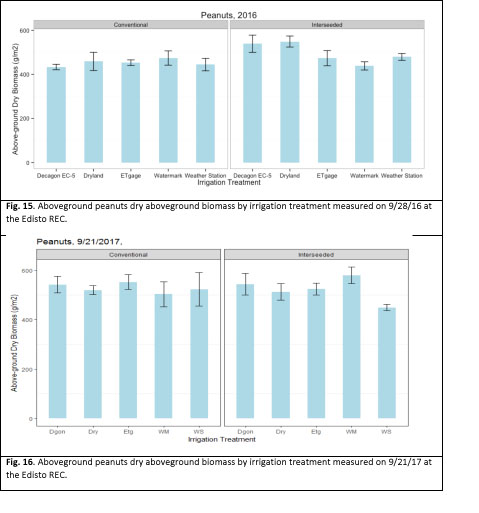
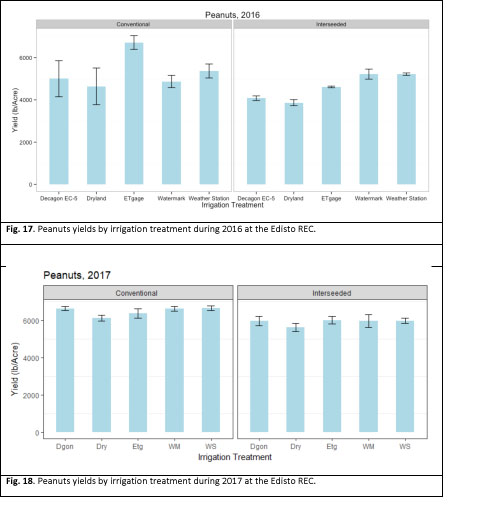
Summary:
Conventional cotton, peanut, and soybean productions required deep tillage with a strip-till system. However, due to controlled-traffic patterns associated with the interseeding system, deep tillage before wheat benefited interseeded soybeans, peanuts, and cotton; therefore, conventional production methods required more fuel than interseeding system.
Interseeding system significantly increased soil organic matter compared to conventional mono-crop soybean and cotton production systems. It also significantly increased plant available nutrients and reduced Nematode population densities in the interseeded cotton fields due to wheat residue.
Educational & Outreach Activities
Participation summary:
Training field days and workshops were offered to farmers, county extension agents, agricultural-related businesses, and policy makers at geographically diverse locations in South Carolina. Also, results were presented at the scientific and local meeting. The benefits of interseeding technology were demonstrated or presented during the following workshops, field days, scientific and local meetings:
- March 24, 2016. Growers meeting, Chester, SC
- July 24-27, 2016. 71st International Annual Conference, Managing Great River Landscapes, Louisville, Kentucky.
- August 11, 2016. Edisto Annual Field Day
- September 13, 2016. Pee Dee all crop field day
- September 15, 2016. Monsanto Field Day, Hampton County.
- November 15, 2016. CCA Workshop, Santee, SC
- February 8, 2017, Agronomic grower meeting, Dillon, SC
- February 24, 2017, Agronomic grower meeting, Hampton, SC.
- February 13, 2017, Agronomic grower meeting, Anderson, SC.
- February 27, 2017, Agronomic grower meeting, Darlington, SC.
- July 20, 2017, Weed Management Field Day at Edisto REC.
- August 25, 2017, Simpson REC agronomy field day, Simpson REC.
Learning Outcomes
Growers learned the benefits and cost savings associated with the interseeding system in South Carolina.
Project Outcomes
Interseeding_SSARE_SummaryReport1617
Accomplishments
This project has developed information, methodologies, and technologies that will provide growers and consultants with effective and affordable tools to adopt innovative conservation technologies for crop production to enhance soil properties, environmental quality, and farm profits, while reducing energy consumption and pest occurrence.
Summary
Conventional cotton, peanut, and soybean productions required deep tillage with a strip-till system. However, due to controlled-traffic patterns associated with the interseeding system, deep tillage before wheat benefited interseeded soybeans, peanuts, and cotton; therefore, conventional production methods required more fuel than interseeding system.
Interseeding system significantly increased soil organic matter compared to conventional mono-crop soybean and cotton production systems. It also significantly increased plant available nutrients and reduced Nematode population densities in the interseeded cotton fields due to wheat residue.